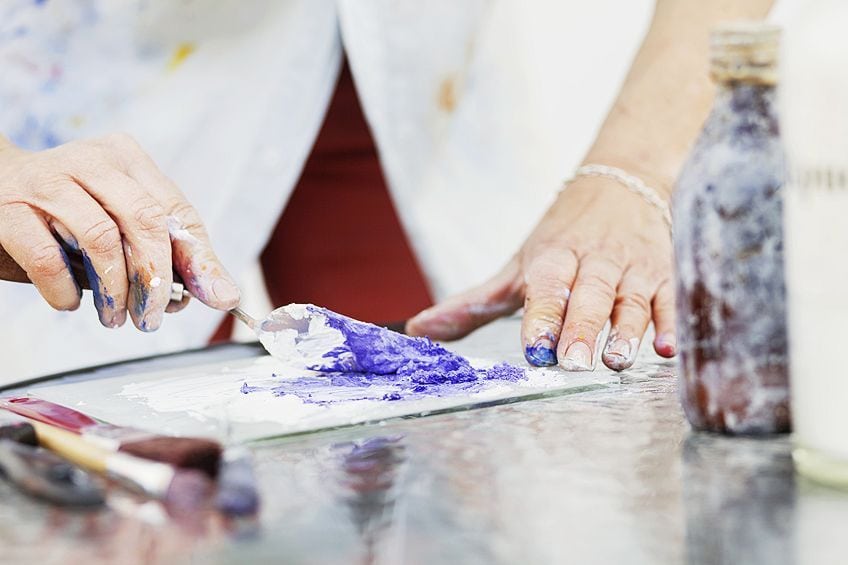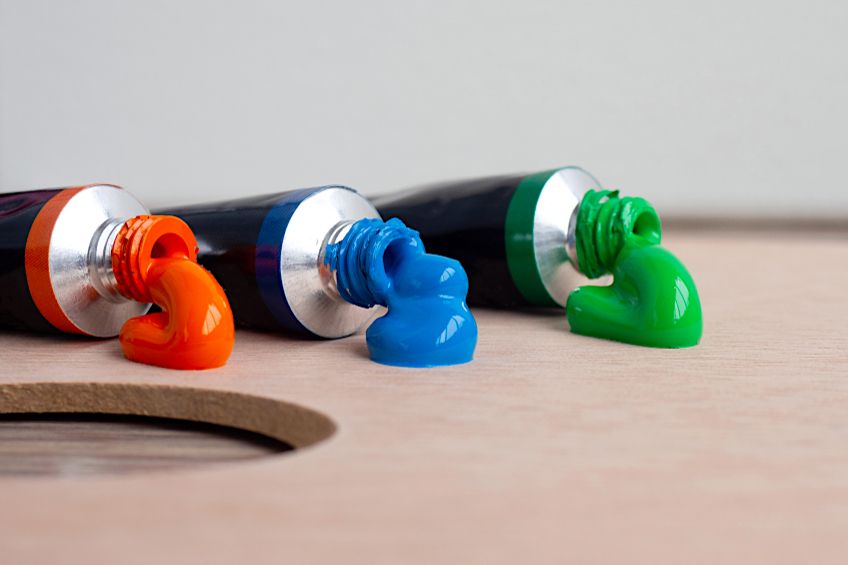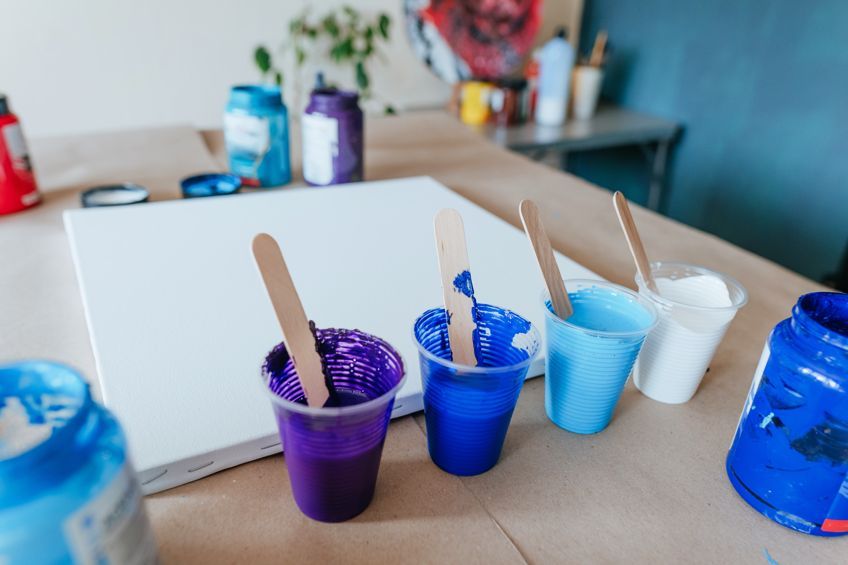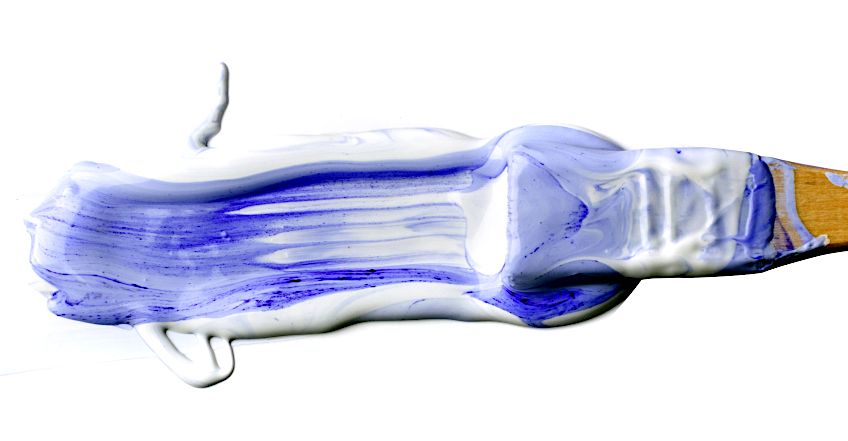How to Thin Acrylic Paint – Mediums for Washes and Pours
Painting with acrylics is one of the most common ways people around the world go about their painting, but can you thin acrylic paint to achieve different effects? Yes, you absolutely can! Thinning acrylic paint can be done in many different ways and is an easy way to provide some variation in finish and consistency if you want to experiment with this medium. You can easily create acrylic paintings with watercolor effects, or try your hand at pouring paints to create abstract paintings once you have thinned down some of your favorite acrylics. If you are asking yourself “what does paint thinner do?” then you will be happy to know that this article is all about how to make acrylic paint thinner and what you need to do it.
What Is Acrylic Paint?
When talking about thinning acrylic paint you need to have an understanding of what acrylic paint is and what it is made of. Acrylic paint is made of pigment, a polymer emulsion, and some water. The ingredients of acrylic paint as well as some of the occasional extra ingredients give acrylics many positive characteristics. Some of these characteristics include a fast drying time, easy application, little to no odor, and non-flammability. Acrylic paint is possibly most well-known for being water-soluble.
The pigment is the ingredient in acrylic paint that provides the color. Pigments can be either organic or synthetic and are made of tiny colored particles that are suspended in the polymer emulsion without dissolving. A polymer emulsion is made when the vehicle, which in the case of acrylic is water, combines with the binder. Once the water evaporates from the acrylic paint all that remains is the dry film of colored polymer that we all recognize as dried acrylic paint.

The primary contributor to acrylics’ popularity is that it dries so quickly. In ideal conditions, a thin application of acrylic can be fully dry in around ten minutes. Acrylic paint that is applied more thickly can take longer to dry but should still dry completely within an hour. The flexibility and elasticity of acrylic paint come from some additives it may contain depending on the brand. These characteristics allow the paint to expand and contract with ease which helps prevent the acrylic from cracking or flaking. Even completely dried acrylic paint will remain fully flexible and elastic.
Binders help with adhesion help the paint dry fast and evenly, and provide the characteristic glossy appearance of acrylic paint. The binder is also known as the acrylic polymer. Its primary functions are to hold the pigment and to form a flexible, protective film once the paint has dried
Why Would You Want to Thin Acrylic Paint?
Thinning acrylic paints is the process of adding water or any other medium to acrylic paints. This process will slowly dilute the paint and give it a lighter and more viscous consistency. You can thin acrylic paint when the consistency is too thick for your preferences or purposes. Thinning acrylic paints helps to achieve a different consistency, subtly alter color, or to create different effects. For example, thinned acrylic paint may even look like watercolor. You can also thin acrylic paint to try your hand at creating abstract art by pouring paints onto a canvas.

What Is an Acrylic Medium?
An acrylic medium is a substance that is added to acrylic paint to its properties. There are several mediums that have many different uses. Acrylic mediums can be mixed with acrylic paint to extend drying time, change consistency, or change texture. Mediums can also increase the UV resistance of acrylic paints and change their finish. With regards to using acrylic mediums to thin acrylic paint, there are three mediums that are suitable for the job.
Pouring medium, acrylic binder, and thinning medium are all suitable for use when thinning down acrylic paint. We go into more detail about each of these thinning options further down in this article and highlight our product suggestions for each option.
How to Make Acrylic Paint Thinner
Now that we have discussed what acrylic paint and acrylic mediums are, we can start talking about the different ways that we can thin down acrylic paints for use. There are many different ways to try to thin down acrylic paint effectively, with some ways being more difficult than others. The methods we highlight are tried and tested and have been broken down completely to make your experience very convenient!

This section will include guides and product recommendations so that you do not have to worry about anything other than thinning down your paint for your project. The way you eventually decide to thin down your acrylic paint will depend on your preferences and maybe the price, but each method listed here is guaranteed to provide excellent results regardless of the nature of your project.
To get started just keep reading and discover how easy it is to start thinning down your acrylics that are too thick or how to get your acrylics ready for those special pouring and swirling art projects.
How to Thin Acrylic Paint With a Pouring Medium
Pouring mediums are a type of acrylic paint additive that has been designed to help people thin paint for acrylic pouring. Whether you want to thin the paint down enough that it becomes easily pourable or not, you can use a pouring medium to do it. The amount your paint is thinned will depend on the amount of thinning medium you add to the paint. Start by adding small amounts of thinning medium to your paint and mixing until you reach the desired paint consistency.

Keep in mind that while pouring medium preserves the colors in your paint and readily improves the flow, you will find that the paint will take longer to dry than usual. Drying time acts as the trade-off for an improved flow rate of your acrylics when using acrylic pouring medium to thin acrylic paint.
Best Pouring Medium for Thinning Acrylic Paint: LIQUITEX Professional Pouring Effects Medium
This fluid pouring medium by Liquitex incorporates an acrylic polymer to ensure that the binder in your paint is not broken down during the thinning process. Liquitex Professional Pouring Effects Medium creates even puddles, flowing applications of color, and smooth, poured sheets. When mixed with acrylic paints this pouring medium promotes even, seamless drying while strengthening the body of the paint and providing a glossy finish. This Liquitex pouring medium does not add transparency to the acrylic paint when mixed and does not alter the colors in any way. It also does not crack upon drying or cause bubbles when pouring and mixing.
- A fluid medium with acrylic polymer and high resin solids
- Creates even puddles, poured sheets, and flowing applications
- Mix with Soft Body Acrylic to promote drying with an even film
- Doesn’t dilute acrylic binder
- Assists with even drying
- Strengthens paint body
- Does not crack or form bubbles
- Reputable manufacturer
- Strong odor
- A bit pricey
How to Thin Acrylic Paint With an Acrylic Binder Medium
An acrylic binder is another great product choice to use when thinning acrylic paint. Acrylic binder does not alter the characteristics of your paint in any other way aside from making it more fluid and more willing to adhere to surfaces. In fact, you will recall from earlier sections of this article that an acrylic binder is a crucial ingredient of acrylic paint.

The binder does not break down acrylic paint in any way, and will even add a beautiful, shiny, glossy finish to the paint once it dries. It is best to err on the side of caution and not use over 50% acrylic binder when thinning acrylic paint, as using more than a 1:1 ratio of binder to acrylic can cause you to lose some color intensity.
Best Binder Medium for Thinning Acrylic Paint: PEBEO STUDIO Transparent Acrylic Binder
This transparent acrylic binder from Pebeo Studio is non-yellowing, translucent, and has a smooth glossy finish. Pebeo studio binder will dilute the color somewhat once mixed but adds luminosity and smoothness to the colors. It can be mixed with water to create a retouching and sealing varnish or can even be used in place of mod podge. The binder does not cause any adhesion problems when mixed with acrylic paint but instead strengthens and increases the durability of paint once mixed.
- Non-yellowing binder with a glossy and translucent film
- Gives depth and brightness to acrylic paint mediums
- The liquid binder is perfect as a varnish or color diluter
- Strengthens paint and adds durability
- Has a smooth, glossy finish
- Adds luminosity and smoothness to colors
- Can be mixed with water to form a retouching or sealing varnish
- Doesn’t cause adhesion problems
- Strong odor
- Dilutes color
How to Thin Acrylic Paint With a Thinning Medium
Some artists prefer using a thinning medium to dilute their acrylic paint. Using a thinning medium is one of the best ways to thin acrylic paint because you don’t need to worry about any ratios. Your paint will not peel off of surfaces or have its color altered, regardless of how much thinning medium you add to your acrylic paint. A thinning medium can also enhance the binding qualities of paint and can act as a primer for any consecutive acrylic paint layers.

The thinning medium will not affect the binding or adhesive capabilities of the acrylic paint. This means that thinning medium is an effective way to preserve your artworks over time because it helps in forming a stable layer of paint. Be sure to always read the product’s instructions carefully and follow them properly to ensure the best results. Don’t purchase cheap products that could damage the integrity of your thinned-out paints, but rather pay a bit extra to purchase a high-quality product with a satisfaction guarantee.
Best Thinning Medium for Thinning Acrylic Paint: VALLEJO Airbrush Paint Thinner
This thinning medium from Vallejo readily dilutes paint without diluting the colors or causing durability or consistency issues. It can be used to thin down paints for painting and pouring but is also suitable for use in an airbrush or spray brush. The low odor of this product makes it great to work with, and suitable for use in confined spaces. This thinning medium may greatly speed up the drying time of your paint once mixed, which can become a wasteful issue if it starts to dry out your paint before it can be used.
- Perfect for model air and liquid acrylic paint mediums
- Dilutes paint without affecting color adhesion or consistency
- Can be used to dilute paints for airbrushing and painting
- Dilutes paint without affecting adhesion and durability
- Does not affect colors
- Low odor
- Affordable
- Can also be used to prepare paints for spray or airbrushing
- Greatly speeds up the drying time of the paint
- Has no specific finish
How to Thin Acrylic Paint With Water
Can you add water to acrylic paint? You can skip buying any specialized mediums altogether by just thinning acrylic paint using water. Water is one of the most common ways to thin acrylic paint. Using water to thin acrylic paint is also the cheapest way available to artists, but is not the most effective way to go about thinning acrylics.
Water affects the composition of acrylic paint directly, by dissolving the binder as it dilutes the acrylic paint. The problem comes in when too much water is added to the acrylic paint and the binder completely breaks down, leading to adhesion problems.

When adding water to acrylic paint to create a wash, you can create a mixture that is around up to 50 percent water without many issues but this will dilute the color quite a bit and will break down the adhesive qualities of the paint completely. You will need to use an absorbent surface if you choose to use this much water to thin your acrylic. If you want the paint to retain its color and adhesive qualities you must create a mixture with 30 percent water or less.
If you opt to use water you should be sure to use distilled water to avoid chemicals, dirt, and other particles that can negatively affect and alter your paint. Use a small amount of paint.
How to Thin Acrylic Paint With Spirits, Paint Thinners, Acetone, or Alcohol
Some artists prefer using one of many different chemical thinners to thin down their paint. We do not recommend this method for thinning acrylic paint. This is because many chemical thinners such as acetone, paint thinners, or alcohol can damage the color of the paint and break down the binder.

This can cause adhesion issues and negatively affect the outcome of your painting once you get started. Using chemical thinners to thin acrylic paint is not recommended for beginners. The best and easiest way to thin acrylic paint is to use acrylic mediums, not spirits or chemical thinners.
Regardless of why you would want to thin acrylic paint, the methods and products highlighted in this article will help you do so effectively. Once you start thinning acrylic paint and experimenting with different techniques you will find that acrylic is even more versatile than you previously thought. Learning how to change and manipulate your painting mediums to achieve different effects will greatly benefit you on your artistic journey and help you improve your skills exponentially in no time!
Frequently Asked Questions
Can You Thin Acrylic Paint With Alcohol?
You can thin acrylics with rubbing (isopropyl) alcohol, although you shouldn’t use more than 20% alcohol in a mixture when thinning. Using too much alcohol can speed up the drying time of acrylic paint even more and will often result in uneven drying.
Can You Thin Acrylic Paint With Mineral Spirits?
You shouldn’t try to thin acrylic paint with mineral spirits. Spirits are petroleum-based and break down the acrylic binder. This will cause adhesion problems once you start trying to paint. We don’t recommend using mineral spirits to dilute acrylic paint.
What Does Paint Thinner Do?
Paint thinner for acrylic paint is a solvent that can be used to break down and remove dried acrylic paint from a surface. You shouldn’t use solvents such as paint thinner for acrylic paint to try to dilute your acrylic paint as it will break down the binder. You should instead use one of the methods highlighted above, such as using a thinning, pouring, or binder medium.
Can You Thin Acrylic Paint With Acetone?
You can use acetone to thin down acrylic paint but you will run the risk of breaking down the binder and having adhesion issues. Use a 4:1 ratio of paint to acetone to avoid breaking down the binder too much.
Can I Use Thinned Paint in a Sprayer or Airbrush?
You should always use thinned paint in a sprayer or airbrush but you must make sure that you have thinned the paint in a way that is suitable for use with these application methods. Read the guide for your sprayer or airbrush to see how you should appropriately thin your paint before getting started.
How Can I Make Acrylic Paint Thinner?
If you are wondering how to make acrylic paint thinner you should look into purchasing some kind of suitable medium. We suggest trying a thinning, pouring, or binder medium when thinning acrylic paint.
Can You Add Water to Acrylic Paint?
You can add water to thin acrylic paint but you must be sure to use no more than 50% water in a mixture. Using more water than this will break down the binder and cause adhesion issues.
In 2005, Charlene completed her Wellness Diplomas in Therapeutic Aromatherapy and Reflexology from the International School of Reflexology and Meridian Therapy. She worked for a company offering corporate wellness programs for a couple of years, before opening up her own therapy practice. It was in 2015 that a friend, who was a digital marketer, asked her to join her company as a content creator, and this is where she found her excitement for writing.
Since joining the content writing world, she has gained a lot of experience over the years writing on a diverse selection of topics, from beauty, health, wellness, travel, and more. Due to various circumstances, she had to close her therapy practice and is now a full-time freelance writer. Being a creative person, she could not pass up the opportunity to contribute to the Art in Context team, where is was in her element, writing about a variety of art and craft topics. Contributing articles for over three years now, her knowledge in this area has grown, and she has gotten to explore her creativity and improve her research and writing skills.
Charlene Lewis has been working for artincontext.org since the relaunch in 2020. She is an experienced writer and mainly focuses on the topics of color theory, painting and drawing.
Learn more about Charlene Lewis and the Art in Context Team.
Cite this Article
Charlene, Lewis, “How to Thin Acrylic Paint – Mediums for Washes and Pours.” Art in Context. April 21, 2022. URL: https://artincontext.org/how-to-thin-acrylic-paint/
Lewis, C. (2022, 21 April). How to Thin Acrylic Paint – Mediums for Washes and Pours. Art in Context. https://artincontext.org/how-to-thin-acrylic-paint/
Lewis, Charlene. “How to Thin Acrylic Paint – Mediums for Washes and Pours.” Art in Context, April 21, 2022. https://artincontext.org/how-to-thin-acrylic-paint/.












